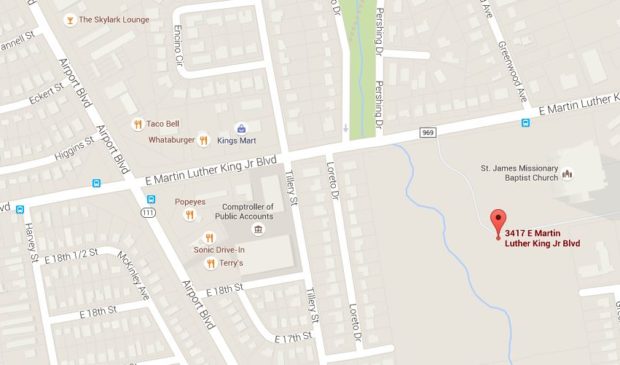Planning Commission OKs zoning change for St. James Baptist Church
Thursday, July 7, 2016 by
Jack Craver Concerns voiced by neighbors about gentrification and traffic resonated with members of the Planning Commission but ultimately did not sway members from recommending a zoning change that will turn a plot of undeveloped land in East Austin into dozens of condominium units.
The 6.27-acre parcel at 3417 Martin Luther King Jr. Blvd. is owned by the St. James Baptist Church, which says it must sell the land to a developer to pay off debt. To that end, it is requesting that the city rezone the property from SF-3, which allows for medium-density single-family homes and duplexes, to SF-6, which would allow a multifamily condominium complex.
City staff gave its blessing to the church’s request, saying in its report to the commission that it would be difficult to build the types of homes authorized under current zoning because of the “physical constraints” of the parcel, including its trees, its peculiar shape and the tributary from the Tannehill Branch Creek that snakes along the eastern border of the property.
Laura Toups of Urban Design Group, which is representing St. James in the zoning case, told the commission that although the church would not be developing the land on its own, it was committed to a project that would be a quality addition to the neighborhood.
“They will stay engaged because they’ve been at this site for 50 years, and the pastor tells me it’s going to be another 50 years, at least, that they’re there,” she said.
The denser zoning would produce a superior product, she said, because it would allow for a clustering of condos that would open up larger areas of green space.
Representatives from area neighborhood associations disagreed, saying that such a dense development threatened the character of the area, which is currently dominated by single-family homes.
Dan Daniels, a former president of the J.J. Seabrook Neighborhood Association, which has not taken a position on the case, said the zoning change would “probably effectuate a massive class shift” by introducing what he predicted would likely be units targeting those with higher incomes than current area residents.
Those concerns were echoed by Andrew Bucknall, president of the Martin Luther King Neighborhood Association, who said the zoning change undermined the group’s mission to preserve the family-oriented character of the neighborhood.
“This is not housing for families,” he said. “This is going to be single people who are in close proximity to UT, an area which is rapidly gentrifying. It’s going to bring in a whole new demographic of people, and it’s going to have a lot of impact on our neighbors.”
Bucknall’s group had voted unanimously, he said, to oppose the zoning change, not because it didn’t support St. James’ efforts to retire its debt, but because it wanted to work with the church to find a more appropriate use of the land.
Approving the requested zoning, he said, required a “leap of faith.”
“And this is not the type of faith in God or some greater power,” he said. “This is faith in some developer who we don’t know.”
One of the biggest concerns for commissioners is the fact that the eventual development will not be able to access E. MLK Jr. Boulevard. Building a driveway or road to the major arterial is barred due to water quality and environmental regulations related to a tributary from Tannehill Branch Creek that trickles through the eastern boundary of the parcel. That means the residents will have to instead rely on a tiny segment of E. 17th Street located to the west of the land.
“Forcing the access onto the small neighborhood streets is very concerning to me,” said Commissioner Patricia Seeger. “I just don’t think the infrastructure is there to add 72 more households and 500 more trips a day to those streets.”
Commissioner Angela Pineyro De Hoyos said the zoning change asked the neighborhood to give up too much in exchange for very little. She cited affordable units or additional parkland as assets the neighborhood might be willing to accept in exchange for additional density.
The poor transportation connections and concerns voiced by the neighbors led a number of commissioners to a position of compromise: recommend the zoning change, but cap the number of units at 60, below the 72 the developer would typically be entitled to.
Commissioner James Schissler argued against the cap, saying that if the goal was to foster affordability, reducing the number of units would simply force the developer to raise the price for each condo.
The commission ultimately voted 8-4 in favor of the zoning change with the unit limit, with Schissler, Pineyro De Hoyos and commissioners Chito Vela and Michael Wilson in opposition.
The approved motion also included a request to city staff to explore ways to connect the development to the J.J. Seabrook Greenbelt, which currently ends at MLK Boulevard, north of the property. Such a connection, said Commissioner Nuria Zaragoza, would be a “great community benefit.”
In an interview with the Austin Monitor, Toups expressed skepticism of the trail connection. She cited the lack of a pedestrian crossing at MLK Boulevard and said that a trail running through the property would run into a cemetery on its southern border.
“It’s not necessarily a trail that will go anywhere,” she said.
You're a community leader
And we’re honored you look to us for serious, in-depth news. You know a strong community needs local and dedicated watchdog reporting. We’re here for you and that won’t change. Now will you take the powerful next step and support our nonprofit news organization?




